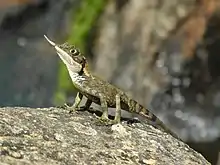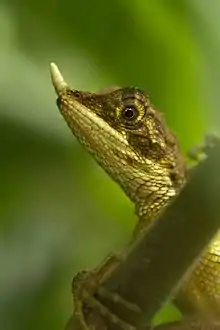Rhino-horned lizard
The rhino-horned lizard (Ceratophora stoddartii), also commonly known as Stoddart's unicorn lizard and the horned agama, is a species of lizard in the family Agamidae. The species is endemic to Sri Lanka. It is called kagamuva angkatussa-කගමුව අං කටුස්සා in Sinhala.
| Rhino-horned lizard | |
|---|---|
 | |
| Male | |
 | |
| Female | |
| Scientific classification | |
| Kingdom: | Animalia |
| Phylum: | Chordata |
| Class: | Reptilia |
| Order: | Squamata |
| Suborder: | Iguania |
| Family: | Agamidae |
| Genus: | Ceratophora |
| Species: | C. stoddartii |
| Binomial name | |
| Ceratophora stoddartii Gray, 1834 | |
Etymology
The specific name, stoddartii, is in honor of Charles Stoddart, who was a British army officer and diplomat.[1]
Habitat and distribution
C. stoddartii is found widespread in montane forests of central Sri Lanka. Localities from which it has been recorded include Nuwara Eliya, Hakgala, Pattipola, Ohiya, Horton Plains, Hewaheta, Dimbula, Agarapathana, and Adam's Peak.
Description
The head of C. stoddartii is oval, and longer than wide. The rostral appendage is long, horn-like, about two thirds the length of the snout in males, but is reduced or even absent in females. The lamellae under the fourth toe number 23–27. The dorsum is brownish green or yellowish brown. The tail is marked with 10–16 dark brown crossbands. The venter is light brownish gray.
Ecology
A slow moving, arboreal species,[2][3] C. stoddartii is found on trees from 1 to 2 m (3.3 to 6.6 ft) above the ground. When threatened, it opens its mouth wide, revealing the bright orange lining of the oral cavity.[3]
The presence of relatively larger trees as well as plants with low to medium levels of DBH is an important factor for C. stoddartii which spends most of its time resting vertically on a tree trunk or a branch. When weather conditions are too harsh they tend to take refuge inside the mosses that are abundant in the Cloud Forests.[2] Tree barks with different shades (grays and browns) and mosaics of lichens & mosses provide the ideal background for C. stoddartii to merge with. Higher perch height of the adult males can be assigned as a feature of territorial defense and attracting the females.[2]
The ground is less frequently used by adult C. stoddartii except for the occasional hunting sprints to catch the escaping prey. However, it has been observed on the ground feeding on caterpillars and even on earth worms (Pheretima taprobenia).[2] When it descends to the ground it changes its green and brown colors into more shades of brown and becomes well camouflaged with the leaf-litter.[2]
Reproduction
C. stoddartii is oviparous. Egg laying takes place in July, and clutch size is about 2–5 eggs, each measuring 7.6-8.1 by 13.5–14.5 mm (.31 by .55 inch). The eggs are deposited in a hole, and hatch after 81–90 days. However, hatchlings have been founded in the wild also during colder months such as December and January. Hatchlings which emerge from eggs laid in humus or among leaf litter can be observed frequently occupying the ground where dead branch sticks and leaf litter well camouflaged them from the possible predators.[2][4][3]
See also
References
- Beolens, Bo; Watkins, Michael; Grayson, Michael (2011). The Eponym Dictionary of Reptiles. Baltimore: Johns Hopkins University Press. xiii + 296 pp. ISBN 978-1-4214-0135-5. ("Ceratophora stoddarti [sic]", p. 255).
- Jayasekara, Dulan; Mahaulpatha, Dharshani; Silva, Anslem (2018-06-13). "Habitat utilization of endangered rhino horned lizard (Ceratophora stoddartii) (Sauria: Agamidae) in the Horton Plains National Park, Sri Lanka". Journal of Entomology and Zoology Studies. 6: 1544–1549.
- Somaweera, R (2009). Somaweera, R. and Somaweera, N., 2009. Lizards of Sri Lanka: a colour guide with field keys. Andreas S. Brahm. pp. 76–77.
- De Silva, Anslem; Ukuwela, Kanishka (2017). A Naturalist's Guide to the Snakes & Other Reptiles of Sri Lanka. John Beaufoy Publishing Limited.
External links
Further reading
- Boulenger GA (1890). The Fauna of British India, Including Ceylon and Burma. Reptilia and Batrachia. London: Secretary of State for India in Council. (Taylor and Francis, printers). xviii + 541 pp. (Ceratophora stoddartii, p. 119).
- Gray JE (1834). Illustrations of Indian Zoology; Chiefly Selected from the Collections of Major-General Hardwicke. Vol. II. London: Adolphus Richter. Plates 1-102. (Ceratophora stoddartii, new species, Plate 68, figure 2).
- Günther ACLG (1864). The Reptiles of British India. London: The Ray Society. (Taylor and Francis, Printers). xxvii + 452 pp. + Plates I-XXVI. (Ceratophora stoddartii, p. 129 + Plate XIII, figures F, F', F").
- Smith MA (1935). The Fauna of British India, Including Ceylon and Burma. Reptilia and Amphibia. Vol. II.—Sauria. London: Secretary of State for India in Council. (Taylor and Francis, printers). xiii + 440 pp. + Plate I + 2 maps. ("Ceratophora stoddarti [sic]", pp. 152–153).
| Wikimedia Commons has media related to Ceratophora stoddartii. |
- Somaweera R and Somaweera N (2009). Lizards of Sri Lanka: a colour guide with field keys. Andreas S. Brahm, pp. 76–77.